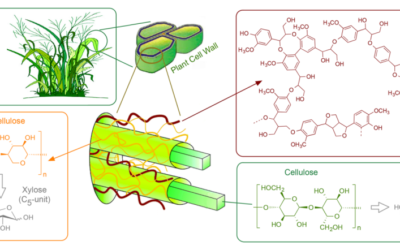![2,5-Furandicarboxylic Acid (FDCA): Discovered in 1876 | Synthesis pathway is adapted from Kamm et al. [5]](https://dalinyebo.com/wp-content/uploads/2014/11/k2_items_cache_519cb84dfa56f4e64bd73c0393e49890_XL.jpg)
2,5-Furandicarboxylic Acid (FDCA): Discovered in 1876 | Synthesis pathway is adapted from Kamm et al. [5]
Aiming for a small slice of the ±50million tpa (polyester) market.
Polyester is a synthetic polymer made of purified terephthalic acid (PTA). Furan-2,5-dicarboxylic acid (FDCA) has been suggested as an important renewable building block because it can substitute for terephthalic acid (PTA) in the production of polyesters [1]. The synthesis of furfural to FDCA is a two step reaction, via furoic acid [2]. It is very old chemistry that goes back to 1930s. Most recently commercial developments of FDCA is based on 5-Hydroxymethylfurfural (5-HMF) as precursor.
Growth: 2014 to 2020 forecast for FDCA is in the order of a CAGR of 367.0% [3, 4]
Market reports[4] forecast FDCA consumption by 2020 to be close to 500,000 tpa and that its market share should be in the following segments:

Grandview Research (Industry Analysis: FDCA-Industry)
Although there are uses for FDCA in market sectors such as PET, polyamides, polycarbonates, plasticisers and polyester polyols, the production of PET from FDCA is expected to have highest potential by 2020. This market segment is forecast to account for over 60% of global FDCA consumption.
Market:
By 2020, the FDCA Market volume is expected to reach about 500,000 tpa. [4]
Why FDCA from Furfural?
The current (semi-)commercial production of FDCA is made via 5-HMF, which is an unstable molecule and requires expensive catalysts for its synthesis. In addition, its commercial viability depends on large-scale production and is reliant on the food industry to supply sugars and/or starches.
Furfural is made on small-scale production units (biorefineries) that are close to the biomass suppliers or attached to a sugar mill (or pulp mill).
Furfural production does not interfere with food-production.
Furfural production contributes to food-security, as its beneficiaries are the farmers, whose crop “wastes” are used to generate additional revenue for them.
Furfural biorefineries have a high socio-economic impact: They require low capital investments and are suitable to be owned and operated by small enterprises or co-operatives and therefore have a direct impact on their local economies (inc. creation of green, rural jobs).
Also See:
![]() Furfural as feedstock for PET alternatives (December 2013)
Furfural as feedstock for PET alternatives (December 2013)
![]() Important chemicals for the production of biomass-based monomers (Nov 2013)
Important chemicals for the production of biomass-based monomers (Nov 2013)
![]() Renewable platform chemical and building block (October 2013)
Renewable platform chemical and building block (October 2013)
![]() Bioplastics: 500% growth = 500% more green chemicals (September 2013)
Bioplastics: 500% growth = 500% more green chemicals (September 2013)
![]() Furoic acid, is the oldest know furan derivative
Furoic acid, is the oldest know furan derivative
![]() Moving the field of furfural and its by-products into the limelight it deserves
Moving the field of furfural and its by-products into the limelight it deserves



